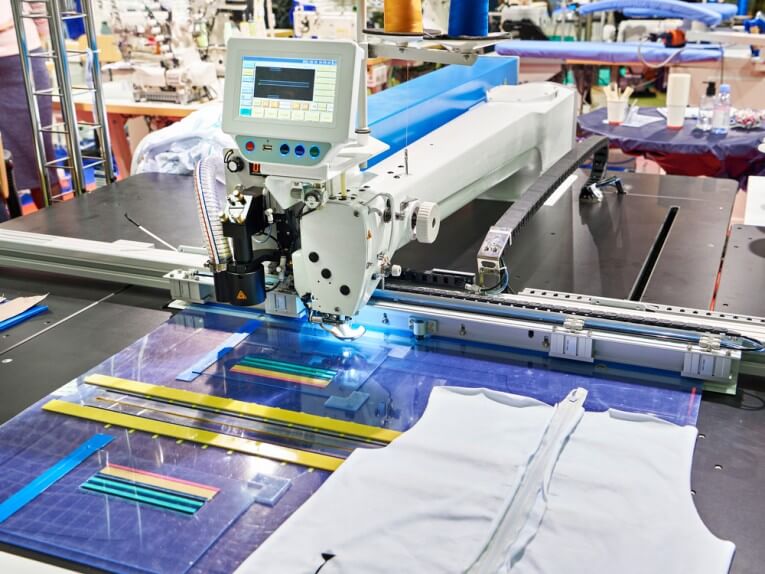Automation has found its way into almost every facet of manufacturing. However, sewing has traditionally been a difficult task for industrial robotics and other automation tools to tackle. New advancements in automation technology are expanding the world of automation for sewing manufacturers, even for sewing tasks previously considered to be too difficult to automate.
Introduction to Sewing Robots
Automated sewing is the application of robotics to industrial and commercial sewing tasks, such as sewing leather, fabrics, and wool. Each of these materials poses challenges, but the lure of increased production rates, efficiency, and reliability has led robot manufacturers to develop answers for the toughest challenges the sector can offer.
Manufacturers have used automation in the fabrics industries for over 100 years, though it has generally been limited to simple tasks such as cutting. In the last few years, however, new products have entered the market to address these limitations.
Why is Sewing so Difficult?
The dexterity and precision required to handle loose, tiny fabric threads can be very difficult to achieve mechanically. The threads are prone to shifting, misalignment, and stretching. Additionally, fabrics are prone to imperfections that require fine adjustments while sewing.
The current generation of machine vision and advancements in robot end effector (the robot’s ‘hands’) technology has opened a world of possibilities for fabric manufacturers. Machine vision allows robots to react to problems with the material by essentially “seeing” when fabric becomes misaligned or creased, allowing it to make adjustments. Advancements in robot movement and end effectors allow for increasingly refined control. Features like torque control provide a “feel” for proper pressure and tension placed on the material.
How Robot Sewing Works
Indeed, robotic sewing is a niche automation application that has specific requirements. For example, many sewing robots are purpose-built to a company’s distinct specifications—there’s no one-size-fits-all solution as can be found in other sectors. Sewing robots also require unique mechanics to sew materials such as sewing heads, extra grippers, and multiple robotic arms and end effectors.
Types of Sewing Robots
Just like any other industry, only certain types of robots are suitable for sewing applications. They are often fitted with special options purpose-built to address the challenges of industrial-scale sewing, including:
1. Six-axis industrial robots
2. Collaborative robots
3. Cartesian robots
4. Dual-arm robots
Comparing Different Options for Sewing
Manufacturers looking to automate their sewing operations have a few options, depending on the specific needs of the application and business.
Sewing automation solutions allow manufacturers to enhance their production capacity in several different ways. Robotics can increase throughput and consistency, and repeatability. These robotic systems generally create less waste and downtime, increasing productivity. Here are a few of the main options to consider:
Cartesian Robots
Cartesian robots (pictured above) are large pieces of equipment that are highly scalable. These popular systems are applied to sewing processes of all sizes. They sew multiple products simultaneously using multiple sewing head attachments. Additionally, these systems can have high-precision engineering to ensure consistency. There are drawbacks, however. Cartesian robots are large, complex pieces of industrial machinery and can be expensive compared to other options.
Articulated Arms
Six-axis, collaborative, and dual-arm robots are another type of automation solution. These robots represent a subset of robots called articulated arms. These machines are highly dexterous, making them perfect for delicate tasks like sewing, where fabrics can be unruly and require fine motor skills to handle. And because they’re such a good fit across a wide array of applications, they’re easy to reprogram and redeploy in a different task. These robots are so adaptable that there’s no reason a sewing cobot can’t be redeployed to a welding task. Swap the end effector for something more appropriate for welding, and it’s ready to be reprogrammed. A cartesian robot, however, is purpose-built and would require a significant overhaul of mechanical components to redeploy it in a new application, such as plasma cutting. Cobots also benefit from being collaborative— they are designed to work near people with a reduced risk of injury.
Even highly adaptable robot arms have limitations, though. They don’t scale well as cartesian and typically can’t sew multiple garments simultaneously. They don’t offer the same speed, and precision found with cartesian robots either.
How to Integrate a Sewing Robot
At this point, you might be excited about the prospect of automating some portion of your sewing process. However, there are still some essential steps to take to make an informed decision.
Define the Scope of Your Project
The most important part of the process begins, unsurprisingly, at the beginning. Properly defining the scope of your project will play a large part in a successful implementation. You should consider factors such as:
1. Details and characteristics of your product
2. Clarify exact steps in the production process
3. Define metrics and key performance indicators (KPIs) around the current process (production rate, efficiency, uptime, etc.) and your desired outcome after automating
4. Identify the true costs associated with the process (raw materials, labor, etc.)
5. Define your available budget
Post time: Mar-06-2023








